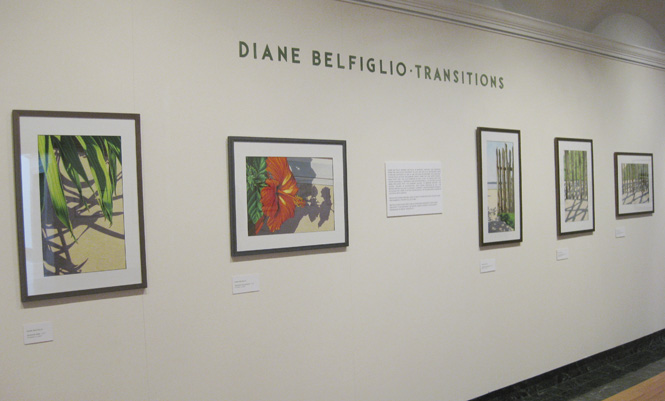Local artist exhibits work in Youngstown
Former KSU professor Diane Belfiglio’s exhibit called “Transitions” will be in the Butler Art Museum in Youngstown until April 3. Submitted photo by Diane Belfiglio.
March 13, 2011
Branching out into the unknown is not easy for those who are comfortable with a daily routine, but it was the decision to branch out in her artwork that earned Ohio artist Diane Belfiglio an exhibition in The Butler Institute of American Art.
The Butler currently holds the exhibition, titled “Diane Belfiglio: Transitions,” in its Butler Giffuni Gallery of American Pastel Art. What makes this exhibition different than past ones is that this is Belfiglio’s first exhibition of oil pastels, which she describes as similar to “drawing with lipsticks.” This is her first exhibition using what she considers a drawing medium rather than an aqueous medium, as she has traditionally painted on canvases.
“Diane Belfiglio: Transitions”
Where: The Butler Institute of American Art
The Beecher Center
524 Wick Ave.
Youngstown, Ohio 44502
When: Feb. 13, 2011 through April 3, 2011
Hours: Tuesday-Saturday: 11 a.m. to 4 p.m.
Sunday: 12 p.m. to 4 p.m.
Contact: (330)-743-1711
For this exhibition, Belfiglio focused on the flowers she sees every day. These include everything from the daffodils in her front lawn that she sees before her morning bike ride, to the red and yellow tulips she noticed on Walsh University’s campus while teaching there. She even admits to finding inspiration in the potted plants on the front porch of her home.
And while the flowers are delicate, yet definite in appearance, the strongest part of each of her pieces is the shadows cast by each flower. These shadows are the main similarity between this exhibition and earlier exhibitions by the artist, and Belfiglio ensures she captures the real shadows from the flowers she sees by photographing what she later plans to draw.
This exhibition was a big jump for Belfiglio, who was used to painting and spending close to 300 hours on one piece of art, mainly focusing on buildings and architecture (and the shadows produced by them).
“I love painting. I love it,” Belfiglio said. “And there’s part of me that misses it, but for right now, this is where I need to be.”
Belfiglio said she can now finish a piece in 12 hours, and she finished the last of the 39 pieces of art for the Butler exhibition two days before Christmas. Working on these pieces was a spiritual relief, she said.
“This is two years of my life,” Belfiglio said. “If you told me a year ago that I’d be doing flowers, I would have told you you were crazy.”
Belfiglio’s surprise at moving to producing flowers in her artwork exists because of her initial focus on realistic architecture and the shadows that went along with the architectural structures. These paintings involved harsher, straighter lines than the flowers she produces with oil pastels.
And while this exhibition is drastically softer than her earlier works, her distinct style, involving the fascination with light and shadow, remains a prominent theme throughout.
Belfiglio’s inspiration for her pieces comes from her favorite three artists: Edward Hopper, Georgia O’Keeffe and Charles Sheeler. She clearly remembers the first time she saw Hopper’s piece “Morning Sun” at the Columbus Museum of Art, where she stood in front of the painting and “didn’t blink or breathe.” The painting, which shows a woman staring out her window toward the morning sun, shows strong shadows from the natural light throughout the room she calmly sits in. Belfiglio was a junior at Ohio State when she saw this painting, and she was working to complete her Bachelor of Fine Arts degree in drawing, painting and graphics.
In addition to working on her art, Belfiglio also made time to teach part-time at Kent State, Syracuse University and The University of Akron. She currently teaches at Walsh University.
Belfiglio earned her Master of Fine Arts degree in painting from Syracuse University in 1980 and has since become a widely known artist. Her work is now in the permanent collection of the Itchiku Kubota Art Museum in Tokyo.
Contact Suzi Starheim at [email protected].












